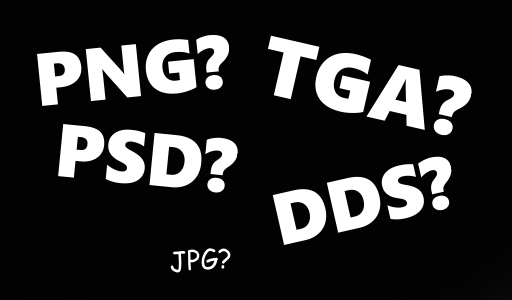I wanted to do a quick comparison of the most common formats. Please feel free to add more context and discuss in the rest of the thread.
TGA : Personally I’ve been a TARGA fan for the longest time. It’s simple and straightforward, no weird shenanigans, not much to say about besides, if you’re in doubt just use TARGA. Only downside I can think of is that typically software (like Photoshop) requires you to explicitly define the alpha channel instead of being able to use the alpha of the canvas.
Pros:
- Ridiculously easy to use.
Con:
- Often uncompressed so it can take up a bit more space.
- Need to explicitly define the alpha channel.
PNG : PNG is interesting, It’s technically lossless but has this quirk where, if you export an image with an alpha channel, it compresses out the rgb info where the alpha is 0. This can be nice if you need something in which alpha and color are linked like a logo. But for a lot of effects, you want the mask to be usable independently of the color information.
There’s also some weirdness with software offering a pre multiplied output, but honestly you’ll want to avoid that 99% of the time anyway.
Pros:
- Typically compressed but still lossless, so often a bit lighter than targa (honestly we rarely care but yeah)
- No need to explicitly define alpha channels
- Widely used and supported
Cons:
- Complex and quirky behavior when used with alpha channel
- When already using targa (which most productions will be) introduces inconsistencies.
PSD: This one depends on the engine you use, but Unreal (and maybe even Unity) support psd as an import format(flattened result). This has some nice benefits. It means you only need to keep track of 1 source file and have that one be linked in your engine. Since we ship the BC textures we might not care about the fact that the psd is massive. However, even more so than PNG the actual imported result can be a bit unpredictable esp. when using alpha, so use with care.
Pros:
- Non-destructive workflows are easier to setup since source file is linked directly
Cons:
- Massive file size (but typically productions keep their source files around anyway in case they want to make adjustments or reuse it)
- Sometimes behaves quirky with alpha info.
DDS: I guess we gotta talk about it. DDS essentially allows you to save block compressed(s3) textures. Personally I wish dds was better supported. Both dds import and export are rarely supported and even if they are they typically only have partial support. On the other hand, this is kinda the opposite of PSD, it creates a destructive workflow where the files you import in engine are already hyper compressed.
Pros:
- More control to directly compress textures yourself instead of relying on the engine to do it for you.
- Small file sizes.
- Shipping memory cost is super obvious (cause you’re just going to ship the file you just created)
Cons:
- Need everyone on production to be more aware of compression.
- Destructive workflow
Jpg : Err, no.

